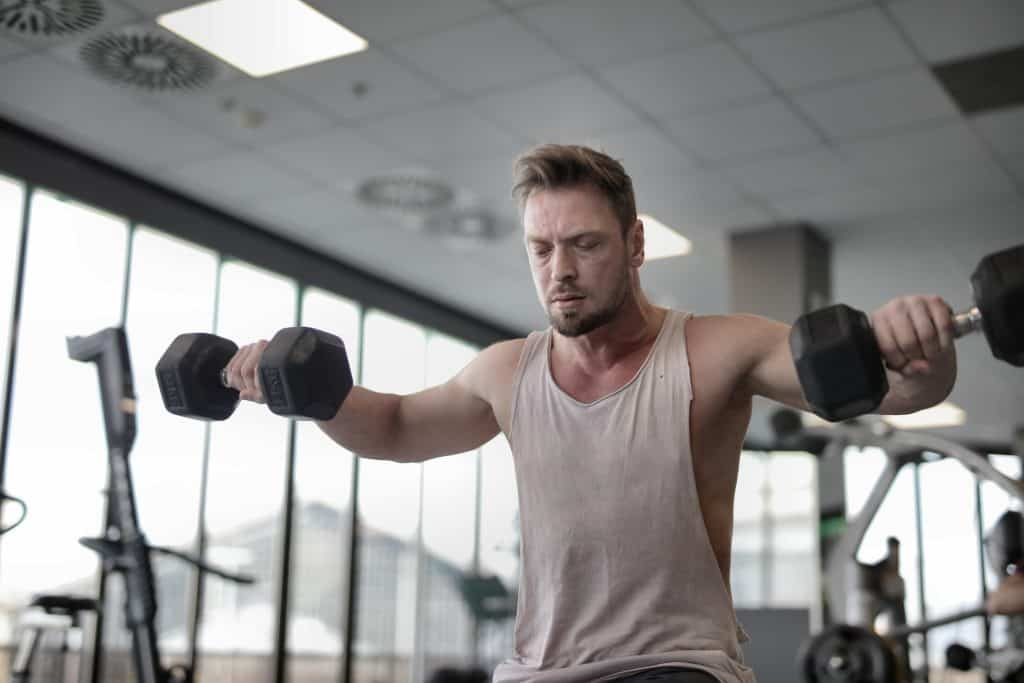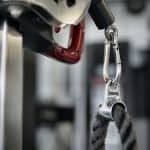The reverse fly is an effective exercise that targets the muscles in the upper back, shoulders, and arms. This exercise is performed using dumbbells, resistance bands, or cable machines, and involves a horizontal pulling motion that works the muscles that are responsible for retracting the shoulder blades.

Reverse Fly
To perform the reverse fly, stand with your feet shoulder-width apart and hold a pair of dumbbells in your hands with your palms facing each other. Keep your arms extended in front of you, and then lift your arms out to the sides, maintaining a slight bend in your elbows, until your arms are parallel to the floor. Hold for a second, then slowly lower your arms back down to the starting position.
The reverse fly is a great exercise for improving posture, as it strengthens the muscles in the upper back that are often weak and overstretched due to poor posture habits. This exercise can also help to prevent shoulder injuries by improving the stability and strength of the shoulder joint.
It is important to start with light weights and focus on proper form when performing the reverse fly to avoid injury. Additionally, individuals with pre-existing shoulder or back injuries should consult with a healthcare professional before incorporating this exercise into their workout routine.
Overall, the reverse fly is a beneficial exercise that can help to improve upper body strength, posture, and shoulder stability. By incorporating this exercise into your workout routine, you can achieve a more balanced and functional upper body.
Reverse Fly Dumbbell
The reverse fly dumbbell exercise is a popular movement for targeting the muscles of the upper back and shoulders. This exercise is performed while lying face down on a bench or stability ball, holding a pair of dumbbells with palms facing in towards each other. From this starting position, the arms are lifted out to the sides in a wide arc, with the elbows slightly bent, until the dumbbells are parallel with the ground. Then, the arms are slowly lowered back down to the starting position, engaging the muscles of the upper back and shoulders throughout the movement.
One of the key benefits of the reverse fly dumbbell exercise is that it targets the often-neglected muscles of the upper back, which can be important for improving posture and preventing injury. Specifically, the reverse fly targets the rhomboids, which are responsible for retracting the shoulder blades, as well as the rear deltoids, which are responsible for shoulder extension and external rotation. Strengthening these muscles can help to improve posture, reduce shoulder pain, and improve overall upper body strength.
To perform the reverse fly dumbbell exercise effectively, it’s important to use the correct form and choose an appropriate weight for your fitness level. Start with lighter weights and focus on maintaining proper form throughout the movement, keeping your shoulders down and back, and avoiding any swinging or jerking motions. Gradually increase the weight as you become more comfortable with the exercise, but always prioritize form over weight. The reverse fly can be incorporated into a full upper body workout routine or used as a standalone exercise for targeting the upper back and shoulders.
Reverse Fly Machine or Rear Delt Machine Fly
Reverse fly machine, also known as the rear delt machine fly, is a piece of exercise equipment commonly found in gyms that is designed to target the muscles of the upper back and shoulders. The machine features a padded seat and chest support, with handles positioned in front of the user that are used to perform the exercise.
During the rear delt machine fly, athletes sit facing the machine with their arms extended in front of them and their hands holding the handles. They then pull the handles back and out to the sides, squeezing their shoulder blades together and engaging the muscles of the upper back and shoulders.
One of the main benefits of using the reverse fly machine is that it provides a controlled and supported movement, which can help to reduce the risk of injury and ensure proper form. Additionally, the machine can be adjusted to accommodate different body sizes and fitness levels, making it a versatile option for athletes of all types.
Like the traditional reverse fly exercise, the rear delt machine fly targets the rear deltoids, rhomboids, and other muscles of the upper back and shoulders. By incorporating this machine into a workout routine, athletes can build strength and stability in these muscles, improve posture, and reduce the risk of shoulder injuries.
Overall, the reverse fly machine, or rear delt machine fly, is an effective exercise option for targeting the muscles of the upper back and shoulders. With proper form and consistent practice, athletes can use this machine to build strength, improve posture, and reduce the risk of shoulder injuries.
Bent Over Flies
Bent over flies, also known as bent over reverse flies or bent over dumbbell flies, are a variation of the reverse fly exercise that is performed while standing, bent over at the waist, with a pair of dumbbells. To perform the exercise, the athlete stands with feet shoulder-width apart and knees slightly bent, holding a dumbbell in each hand, palms facing in towards the body. Then, the athlete bends over at the waist, keeping the back straight, until the chest is nearly parallel to the ground. From this position, the arms are lifted out to the sides in a wide arc, with the elbows slightly bent, until the dumbbells are parallel with the ground. Then, the arms are slowly lowered back down to the starting position, engaging the muscles of the upper back and shoulders throughout the movement.
Bent over flies are an effective exercise for targeting the muscles of the upper back and shoulders, particularly the rhomboids and rear deltoids. The exercise can help to improve posture, reduce shoulder pain, and improve overall upper body strength. However, it’s important to use proper form when performing bent over flies to avoid injury. Athletes should keep the back straight, engage the core muscles, and avoid any swinging or jerking motions.
Bent over flies can be incorporated into a full upper body workout routine. Or used as a standalone exercise for targeting the upper back and shoulders. When performing the exercise, athletes should choose a weight that is appropriate for their fitness level. They should also focus on maintaining proper form throughout the movement. Gradually increasing the weight over time can help to build strength and improve the effectiveness of the exercise. Overall, bent over flies are a challenging and effective exercise for targeting the upper back and shoulders. They can help athletes to build a strong, balanced upper body.
Cable Reverse Fly
The cable reverse fly is an exercise that targets the muscles of the upper back and shoulders using a cable machine. To perform the exercise. The athlete stands facing the cable machine with feet shoulder-width apart, grasping the handles with palms facing down. Then, the athlete takes a few steps back, keeping the arms extended in front of the body. From this position, the athlete pulls the handles out to the sides in a wide arc. With the elbows slightly bent, until the handles are parallel with the ground. Then, the athlete slowly lowers the handles back down to the starting position. Engaging the muscles of the upper back and shoulders throughout the movement.
One of the benefits of the cable reverse fly is that it provides a constant resistance throughout the movement. This can be effective for building strength and muscle endurance. The exercise also allows for greater range of motion compared to other variations of the reverse fly, such as the bent over dumbbell fly. Additionally, the cable reverse fly can be easily modified. Do this by adjusting the height of the cable machine or using different attachments, such as a single handle or a rope attachment.
To perform the cable reverse fly effectively. It’s important to use proper form and choose an appropriate weight for your fitness level. Start with a lighter weight and focus on maintaining proper form throughout the movement. Keep the shoulders down and back, and avoiding any swinging or jerking motions. Gradually increase the weight as you become more comfortable with the exercise, but always prioritize form over weight. The cable reverse fly can be incorporated into a full upper body workout routine. Or used as a standalone exercise for targeting the upper back and shoulders. Overall, the cable reverse fly is a challenging and effective exercise. It’s great for building strength and muscle in the upper back and shoulders.
Reverse Fly Muscles Worked
The reverse fly is an effective exercise for targeting the muscles of the upper back and shoulders. Specifically, the exercise primarily targets the rhomboids and rear deltoids, which are responsible for shoulder retraction, extension, and external rotation.
The rhomboids are a pair of muscles that run from the upper spine to the shoulder blades. They are responsible for retracting the shoulder blades, which helps to improve posture and prevent shoulder injuries. The reverse fly exercise targets the rhomboids by engaging the muscles during the lifting and lowering of the arms in a wide arc. By strengthening the rhomboids, athletes can improve their posture and reduce the risk of shoulder injuries.
The rear deltoids, also known as the posterior deltoids, are the muscles at the back of the shoulder joint. They are responsible for shoulder extension, external rotation, and horizontal abduction. These movements are important for a variety of upper body activities, including throwing, pushing, and pulling. The reverse fly exercise targets the rear deltoids by engaging the muscles during the lifting and lowering of the arms in a wide arc. By strengthening the rear deltoids, athletes can improve their overall upper body strength and performance in a variety of activities.
In addition to the primary muscle groups targeted by the reverse fly exercise. Other muscles are also engaged during the movement, including the trapezius, teres major, and infraspinatus. These muscles work together with the rhomboids and rear deltoids to stabilize the shoulder joint. And maintain proper posture throughout the movement.
Overall, the reverse fly exercise is an effective way to target the muscles of the upper back and shoulders. They put a particular emphasis on the rhomboids and rear deltoids. By incorporating the reverse fly into a full upper body workout routine or using it as a standalone exercise. Athletes can improve their posture, reduce their risk of shoulder injuries, and build a strong, balanced upper body.
Conclusion
In conclusion, the reverse fly is an effective exercise for targeting the muscles of the upper back and shoulders. The exercise primarily targets the rhomboids and rear deltoids, which are responsible for shoulder retraction, extension, and external rotation. By strengthening these muscle groups, athletes can improve their posture, reduce their risk of shoulder injuries. And improve their overall upper body strength and performance in a variety of activities. The reverse fly can be performed using dumbbells or resistance bands. They can be incorporated into a full upper body workout routine or used as a standalone exercise. To perform the exercise effectively, athletes should use proper form. Choose an appropriate weight, and focus on engaging the targeted muscle groups throughout the movement. By incorporating the reverse fly into their fitness routine. Athletes can build a strong, balanced upper body and improve their overall health and fitness.
FAQ
Are reverse flys worth it?
Yes, reverse flies are worth it as they are an effective exercise for targeting the muscles of the upper back and shoulders. By performing reverse flies, athletes can strengthen the rhomboids and rear deltoids. Which are responsible for shoulder retraction, extension, and external rotation. This can improve posture, reduce the risk of shoulder injuries. And improve overall upper body strength and performance in a variety of activities.
In addition, reverse flies can be performed using dumbbells or resistance bands. Thus making them a versatile exercise that can be incorporated into a full upper body workout routine or used as a standalone exercise. They can also be modified to accommodate different fitness levels and goals.
However, it’s important to use proper form when performing reverse flies to avoid injury. Athletes should keep their back straight, engage their core muscles, and avoid any swinging or jerking motions. Gradually increasing the weight over time can also help to build strength and improve the effectiveness of the exercise.
Overall, reverse flies are a challenging and effective exercise for targeting the upper back and shoulders. And can help athletes to build a strong, balanced upper body.
What is reverse cable fly good for?
Reverse cable fly is a popular exercise in strength training. It primarily targets the muscles of the upper back and shoulders. This exercise is performed using a cable machine with adjustable weights and a pulley system. Here are some benefits of the reverse cable fly:
- Upper Back and Shoulder Strength: The reverse cable fly is an effective exercise to strengthen the muscles of the upper back and shoulders, particularly the rear deltoids and rhomboids. Stronger upper back and shoulder muscles can help to improve posture, prevent injuries, and enhance overall upper body strength.
- Improved Posture: The reverse cable fly targets the rhomboids, which are the muscles responsible for retracting the shoulder blades. Strengthening the rhomboids through this exercise can enhance posture and prevent shoulder injuries resulting from poor posture.
- Balanced Upper Body Development: Many upper body exercises, such as bench presses and push-ups, tend to focus on the chest and front of the shoulders. The reverse cable fly targets the muscles in the upper back and rear of the shoulders, which helps to create a more balanced and symmetrical upper body.
- Increased Range of Motion: The reverse cable fly involves a wide range of motion, which can help to increase shoulder flexibility and mobility.
Overall, the reverse cable fly is an effective exercise for targeting the upper back and shoulders. While also improving posture, and enhancing overall upper body strength and balance. You can perform it with different weights and modifications to suit your fitness level and goals.
Is reverse fly hard?
The difficulty of reverse fly exercise can vary depending on a few different factors. Consider an individual’s fitness level, experience with strength training, and the weight they are using.
For beginners or those who are new to strength training. The exercise may feel challenging, as it requires good form and proper engagement of the targeted muscle groups. It may also take some time to build up the strength needed to use heavier weights.
However, with proper form and consistent practice, reverse fly can become a manageable exercise. You can modify it to suit different fitness levels and goals. For example, starting with light weights or resistance bands can help to build strength and improve form. While gradually increasing the weight over time can help to challenge the muscles and improve the effectiveness of the exercise.
It’s important to remember that the goal of the exercise is not to lift the heaviest weight possible. It is to perform the movement with proper form. And engage the targeted muscle groups throughout the entire range of motion. Focusing on good form and gradually building up strength can help to make the exercise feel less difficult over time.
Does reverse fly work rotator cuff?
Reverse fly is an effective exercise for targeting the muscles of the upper back and shoulders. This includes the rotator cuff muscles. The rotator cuff is a group of muscles and tendons that surround the shoulder joint. They help to stabilize and rotate the arm.
During the reverse fly exercise, the muscles that make up the rotator cuff are engaged. This helps stabilize the shoulder joint and maintain proper form throughout the movement. This includes the supraspinatus, infraspinatus, teres minor, and subscapularis muscles. Which work together to provide stability and control during arm movements.
Strengthening the rotator cuff muscles can help to improve shoulder stability. And reduce the risk of injury during upper body exercises. By incorporating reverse fly into a workout routine. Athletes can target these muscles and build strength and stability in the shoulder joint.
It’s important to use proper form when performing reverse fly to avoid injury. And to gradually increase the weight over time as strength improves. Additionally, athletes with pre-existing shoulder injuries or conditions. Should consult with a healthcare provider before performing any exercise that targets the rotator cuff muscles.
Other Posts You May Enjoy!
- Push Day Workout – What You Need To Know
 A push day workout is a popular way to build muscle and strength in the upper body. They typically focus on exercises that target the …
A push day workout is a popular way to build muscle and strength in the upper body. They typically focus on exercises that target the … - Cable Lateral Raise: How to Perform the Exercise with Proper Form
 Cable lateral raise is an exercise that targets the middle head of the deltoid muscle, which is the rounded muscle at the very top of …
Cable lateral raise is an exercise that targets the middle head of the deltoid muscle, which is the rounded muscle at the very top of … - Everything You Need to Know About the Face Pull: Benefits, Form & Mistakes to Avoid
 Face pulls are an excellent exercise for the upper back muscles, rear deltoids, and trapezius. They are also great for building strong shoulders, improving posture, …
Face pulls are an excellent exercise for the upper back muscles, rear deltoids, and trapezius. They are also great for building strong shoulders, improving posture, … - “Everything You Need To Know About Shoulder Impingement Exercises: The Ultimate Guide To Exercises For Shoulder Impingement!”
 Shoulder Impingement Exercises Exercises For Shoulder Impingement Are you dealing with shoulder impingement? You can find relief through exercises. These exercises help improve your shoulder’s …
Shoulder Impingement Exercises Exercises For Shoulder Impingement Are you dealing with shoulder impingement? You can find relief through exercises. These exercises help improve your shoulder’s … - “Push Your Limits: The Ultimate Guide to a Killer Push Workout!”
 Push Workout Are you looking for an effective way to build upper body strength and muscle? A push workout may be just what you need! …
Push Workout Are you looking for an effective way to build upper body strength and muscle? A push workout may be just what you need! …
EXPAND YOUR MIND
Join the best newsletter that you never knew you needed. You’ll get emails containing grooming tips, new blog posts, product launches, giveaways, and motivation to help you Keep on Keeping on.



